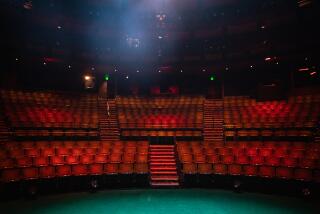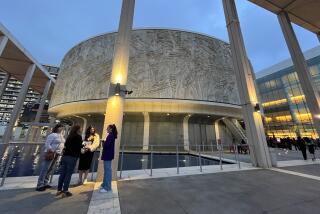New York artists share tips with Californians on how to stay sane in crazy times
- Share via
It was less than three weeks ago — although it feels like three years — that the Metropolitan Opera in New York City shocked arts communities across the nation by announcing that it was canceling the remainder of its 2019-20 season and suspending the employment of its union workers after March.
Since then, performers and musicians in Los Angeles have been waiting to see if the coronavirus crisis will force arts groups on the West Coast to institute similar emergency measures. One dispiriting answer arrived last week when the city’s largest nonprofit theater company, Center Theatre Group, said it would postpone all programming through summer and furlough half of its full- and part-time staff through Aug. 9. The Museum of Contemporary Art followed suit, furloughing or cutting pay for its entire full-time staff except for four security personnel. (Part-time employees, all 97 of them, already had been laid off.)
Former Met employees and contractors had an unfortunate head start on their L.A. counterparts in the arts world when it comes to dealing with the new realities of unemployment coupled with anxiety about a growing pandemic. Three of them took time this week, however, to offer some insight and advice to Californians who might be about to take the same cold, uncertain plunge.
David Gonsier, dancer
When the Met closed, Gonsier was shut out of two upcoming productions and lost 20% of his annual income, money he was counting on to get through the summer.
“The unemployment rate for performers around the world is basically 100%” Gonsier said, referencing how work on the stage and screen has basically shuddered to a halt.
As a member of the board of governors for the American Guild of Musical Artists, which represents dancers in the New York region, as well as a co-founder of Dance Artists’ National Collective, a group of freelance dancers that advocates for safe and equitable working conditions, Gonsier had some valuable advice: Get to know your rights under the newly passed Coronavirus Aid, Relief and Economic Security Act (known as the CARES Act).
“The CARES Act includes a provision for pandemic unemployment assistance,” Gonsier said, explaining that in New York that meant an additional $600 per week on top of a person’s regular unemployment benefits. Those unemployment benefits typically last for 26 weeks, and the pandemic unemployment assistance tacks on an additional 13 weeks, he said.
The CARES Act also allows groups not normally allowed to apply for unemployment — namely freelancer and contract performers, artists and musicians — to do so.
“A lot of the furloughed workers will be qualified for this,” Gonsier said.
Union employees affiliated with AGMA can apply for assistance through the AGMA relief fund, which Gonsier said saw a nearly $200,000 uptick in donations after Vermont Sen. Bernie Sanders’ presidential campaign named the fund in a recent call for coronavirus relief donations.
With theaters closed, galleries shut and concerts canceled, the arts community is rallying to help its own. Here are places providing financial support.
“AGMA has opened up its criteria for who can apply for assistance and raised the limit for how much they can give you,” Gonsier said.
Most dancers, however, aren’t represented by a union, Gonsier said. A number of mutual aid funds are cropping up to aid those artists. The Actors Fund, for example, which has a long track record of helping those in need, is providing emergency financial assistance.
Dancers in Los Angeles can also turn to the Dancers Alliance as a resource, Gonsier said. That group “has been doing great work to unite the dance community around issues like standardized rates, workplace safety and using collective action to push back against bad practices in the industry. Those efforts are going to be doubly necessary in the coming months, as a worsening economic climate will almost certainly lead to drastic cuts to arts funding.”
Gonsier holds out hope that the Met, and other arts institutions, may reopen in August, but he fears recovery will still be dependent on “public trust in enclosed spaces.” When will anybody be emotionally ready to sit inside a theater with 3,000 other people?
Alexa Jarvis, chorister
Jarvis was a freelance soloist until two years ago, when she was hired full-time at the Met.
“This is the secure move. This is the move that’s going to enable me to have a family, to sleep in my own bed at night and not live out of a suitcase,” Jarvis said of the coveted gig.
If you signed a contract with a major arts group in L.A., Jarvis said, it’s more than likely that you glazed over some small print in your contract that is now getting a lot of use in the coronavirus era: the force majeure clause.
This clause basically limits liability in the face of an unforeseeable event, such as a natural disaster and emergencies like strikes or a quickly spreading pandemic.
“You just sign it, you don’t even think about it,” Jarvis said.
Until it is suddenly invoked to explain why you are no longer going to receive a paycheck.
Jarvis, who lives in an apartment near Lincoln Center with her 4-month-old baby and her husband (also a singer), said she plans to ride out the summer as best she can. She hopes that the Met will reopen for its preseason in late July.
Her advice for artists on the opposite coast?
“As performers it is helpful to feel like we have purpose. Develop a routine. Find someone to care for, even if it’s from a distance,” she said. “I think at the end of this crisis we will be needed more than ever to help heal and inspire the grieving world.”
Michelle Vargo, dancer
As a dancer who tours often, Vargo saw U.S. closures coming as soon as theaters began closing in Europe. On the day the Met finally shuttered, she and another dancer had visited HR with concerns about large groups of performers gathering to audition for Verdi’s “Aida.”
Two hours after she left the building, she heard the news. She was on the way to pick up her 7-year-old daughter from school, and she cried on the train.
Vargo lives in Sugar Hill in Manhattan with her daughter, her 21-month-old son and her partner. The four have been inside since March 26, when things began looking increasingly bleak in the city.
“We hear sirens all day long and all night long,” she said.
Vargo’s advice is to stay connected to people in the arts world.
Also, find an activity that helps others. She is donating her time to teach yoga classes online. She leads two per week, one for her daughter’s school and another for healthcare workers.
“My partner and I just say we have no right to complain. We’re healthy, we’re inside,” she said.
Spending time with her children and paying attention to their needs and natural curiosities provides a silver lining in dark times.
When the Met closed, her daughter was scheduled to perform for the very first time alongside her mother in “Werther.” The following day was supposed to be the show’s final dress rehearsal.
“She had a really hard day,” Vargo said of the day her daughter found out the news.
But the girl soon came up with a solution. She told her mother she would perform in their house every night there was a scheduled performance of “Werther.”
And she has stuck to it. She dresses up and dances each night, and Vargas and her partner give her flowers.
More to Read
The biggest entertainment stories
Get our big stories about Hollywood, film, television, music, arts, culture and more right in your inbox as soon as they publish.
You may occasionally receive promotional content from the Los Angeles Times.












